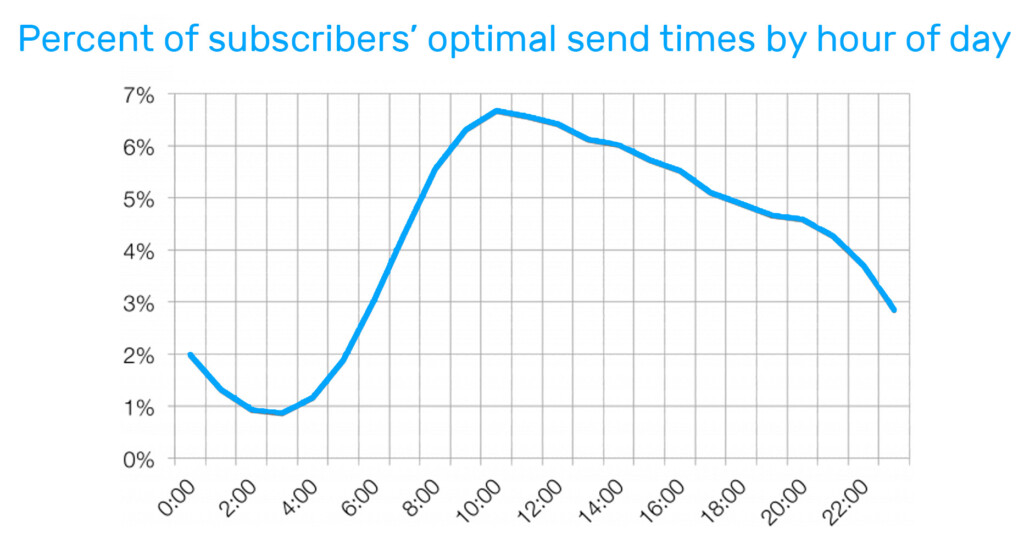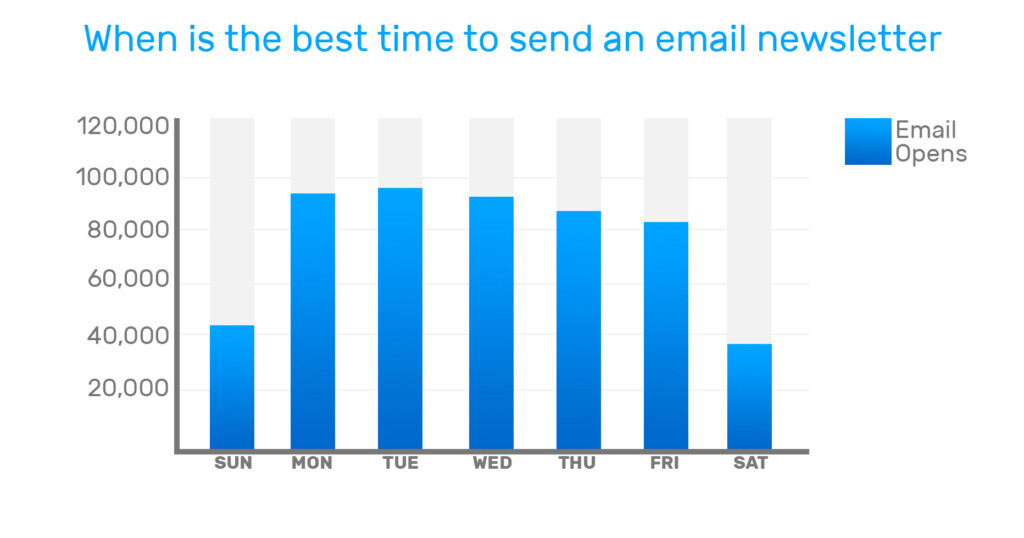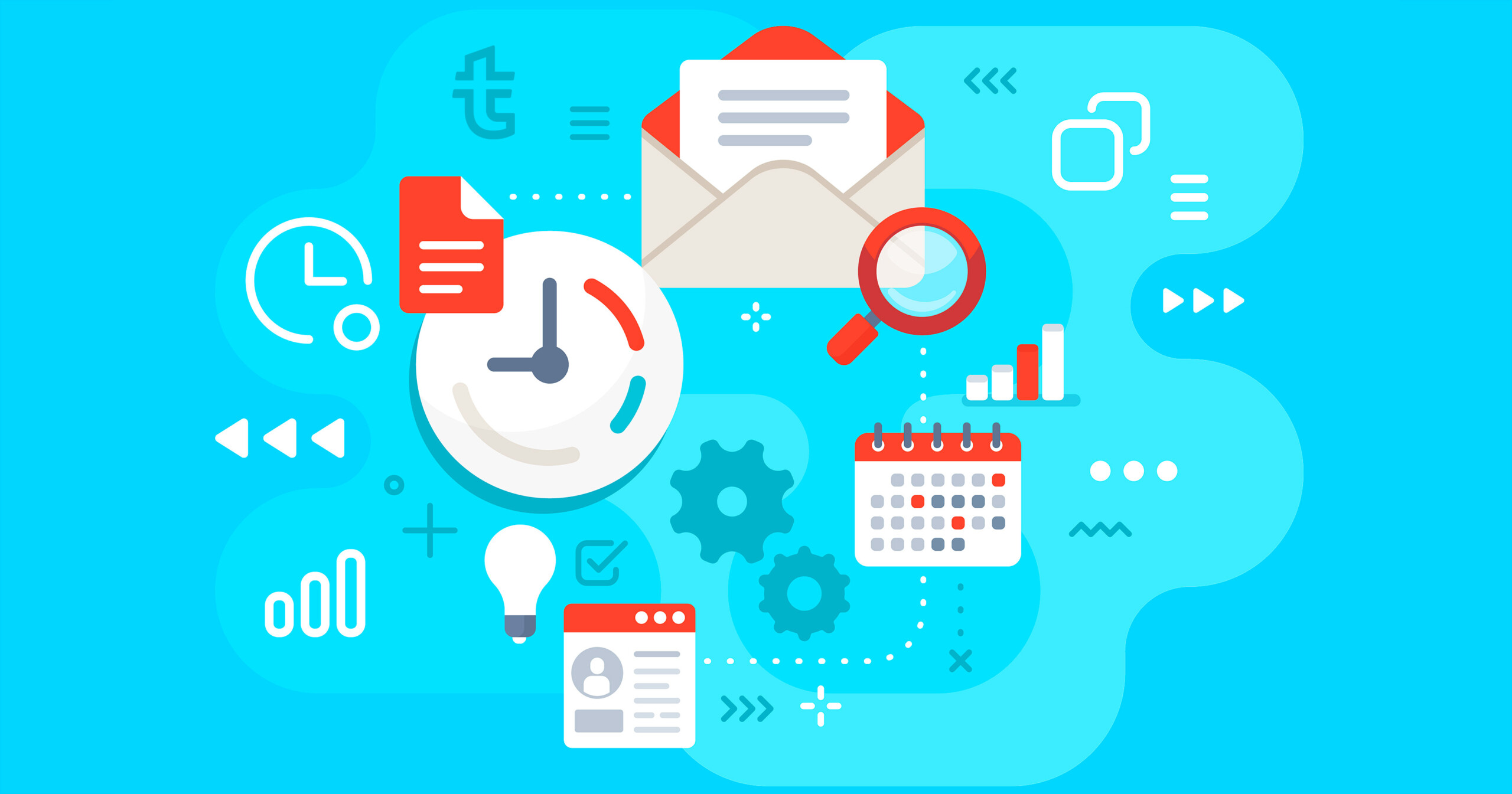Why Time Matters
Sending an email newsletter is a great marketing tool, but its success depends on many factors, and one of them is timing. It is the reason why some emails are opened and read, while others go unnoticed.
To reach out to as many people as possible, one should have an idea of what audience they target and when their newsletter will be likely to get through to the recipient.
Let’s take a look at key terms that are used for the analysis of email performance. They will help understand what elements of the marketing campaign need improvement.
- Open Rate (OR) is a percentage of opened emails for your email marketing campaign. The formula is as follows: opened emails / (sent emails – bounced emails). If Open Rate is low, you must have chosen the wrong timing for sending emails or hadn’t thought through the subject line of your letters. Open Rate calculated for a specific time frame becomes Open Volume.
- Click Rate (CR) is a percentage of emails that received clicks. Calculated for a specific period, Click Rate becomes Click Volume. CR might be low if you haven’t given people a reason to check out your website with the right call-to-action elements.
There is special software to track email marketing performance for blog campaigns such as SendX or SendPulse allowing you to integrate subscription forms on your website, build an email list, send out emails and track user activity. Also, you can track email opens in Google Analytics.
Things to Consider When Choosing the Time
To choose the best time for your newsletter, consider the following aspects that influence whether your email goes unnoticed or not. Email opens and clicks are mostly affected by the time of day and day of the week, but demographics, device on which users view your content, time zone and industry are not to be disregarded.
Time of Day
Various studies have shown that emails sent in certain hours get more clicks than others. Let’s see what research says about the best time of day for email marketing:
- 6 a.m. Many people start their day by checking the mailbox, and this is when your email might get noticed.
- 10 a.m. Mailchimp’s research has proven open rate peak to occur at 10 a.m., regardless of the industry, so it might be the best time to send blog emails.
- 2 p.m. Around this time, people are looking for a distraction and want to take a break from their work, or simply switch the focus.
- 8 p.m. By then, people are supposed to return home from work. Many of them check their email for personal correspondence, so it might be the best time to send blog posts.
- 9 p.m – midnight. This time works perfectly for a young audience who is likely to check the email box late in the evening or even at night.
Even though there are a few intervals during the day when your email is likely to be opened, in general, sending it in the morning is better than in the evening, as you can see from the graph below. And this tendency stays almost the same regardless of the industry.

Pay attention to the time zones of your subscribers. If you have a large international subscribers base, your time and the time of the subscribers are most probably different. We have discussed this in detail below.
Day of the Week
Taking into consideration that the majority of people work Monday through Friday, some days of the week are likely to turn out more successful than others for your email marketing campaign.
- Monday is the first working day of the week, and people march into it anticipating an immense workload, so it isn’t the best day to send emails. Your newsletters are likely to remain unseen or even deleted right away if they are sent on Monday and are not work-related.
- Tuesday shows a slightly higher OR and CR than other days of the week, according to a study from HubSpot, as you can see on the graph below.

- Wednesday has the second-highest open rate in many studies on newsletter performance.
- Thursday comes in the third-best day to send an email blast in terms of open rate.
- Friday might be a bad choice for sending a newsletter. People want to be done with their work as soon as possible and ignore distractions.
- Saturday and Sunday tend to bring extremely low open rates because most people are busy with their families and avoid work-related issues. On the flipside, leisure-related content is more likely to be opened exactly at the weekend.

- Notifications about an upcoming event are not subject to common rules. They should be sent three to five days in advance of your event, regardless of the day of the week. Your email might be opened a day later, so sufficient lead time is always good.
Time Zone
When targeting a global audience, don’t forget about time zones. For local companies, it’s okay to not bother with geolocation, while international corporations should take another step and cater to clients according to their time zone. While analyzing market-specific rates, consider the average metrics for each continent: Europe and Oceania have the highest OR and CR, while Africa stays far behind. As for country-specific metrics, Germany, the Netherlands and France show the highest performance.
Industry
Even though studies show more or less similar open rates for all industries, there are still small differences. The highest open rates are witnessed by nonprofits (36.15%), restaurants and food services (33.10%) and publishing industry (29.64%). The lowest open rate is typical for agencies (16.10%) and internet marketing (17.26%).
Now let’s see industry trends regarding the day of the week:
- The beginning of the week works better for e-commerce and B2B companies, meaning that in the first case, people shop in advance and expect to receive goods by the weekend, and in the second case, checking emails from B2B firms influences the whole working week, so they get opened as early as possible.
- Clients read emails from software companies evenly during the working week.
- Offline retail sees more opens on Thursday and Friday, as the weekend draws near.
- For nonprofits, OR is high during the whole week, as people are motivated to receive such emails, with open peaks on Tuesday and Wednesday.
- Marketing agencies have an open rate peak on Wednesday, as people tend to read work-related emails during the working week, and emails from marketing services are rarely urgent, so they get checked mid-week.
Device
The device your newsletter is going to be opened on means a lot for choosing the timing. The research conducted by Harland Clarke Digital has shown correspondence between the type of device readers used and email performance.
- Users still prefer to open emails on computers: 55.2% of recipients rendered using desktop exclusively. 25.0% of readers use a smartphone only, and 7.3% of users view the content solely on the tablet. 12.4% of recipients use several devices, mostly desktop and smartphone.
- The majority of desktop and smartphone users view content between 3-4 p.m., while tablet readers prefer checking emails outside of business hours, mainly at 8-9 p.m.
- Tablet users show the highest weekend engagement on Friday, Saturday and Sunday among all other recipients, while Wednesday and Thursday account for the highest number of renders despite the type of device.

Run Testing
Now that you have the average metrics, it might be efficient to conduct your own research and find the best timing. It is recommended to have at least 1,000 recipients, whom you’ll divide into two or three groups and run a test for the day of the week and time of day. Schedule emails on various days for each group and run testing. After determining the most efficient day for sending a newsletter, test different timing during the day, let’s say at 10 a.m., 2 p.m. and 8 p.m. When analyzing the results of the research, take into account whether recipients are engaged with different industries and have various time zones.
The Worst Time to Send a Newsletter
Even if determining the best time to send a newsletter seems an obstacle, try to avoid the worst timing identified by multiple studies. As you can see from the graph below, running an email marketing campaign at 6-8 p.m. and 9-12 p.m. is unlikely to bring high open rates. Too many companies target these time frames, so it might be hard to compete. Night hours and 8-9 a.m. are no better, so try to avoid them too.
How to Find the Best Time to Send Your Newsletter
Finding the best time to send an email newsletter involves conducting research on your audience. There are many factors to consider: time zone, occupation, device, day of the week and time of day. Work-related content performs better on weekdays, specifically on Tuesday, Wednesday and Thursday, while weekends bring high rates for newsletters on leisure and hobbies.
In either case, running tests might help determine the best timing for your particular audience.




